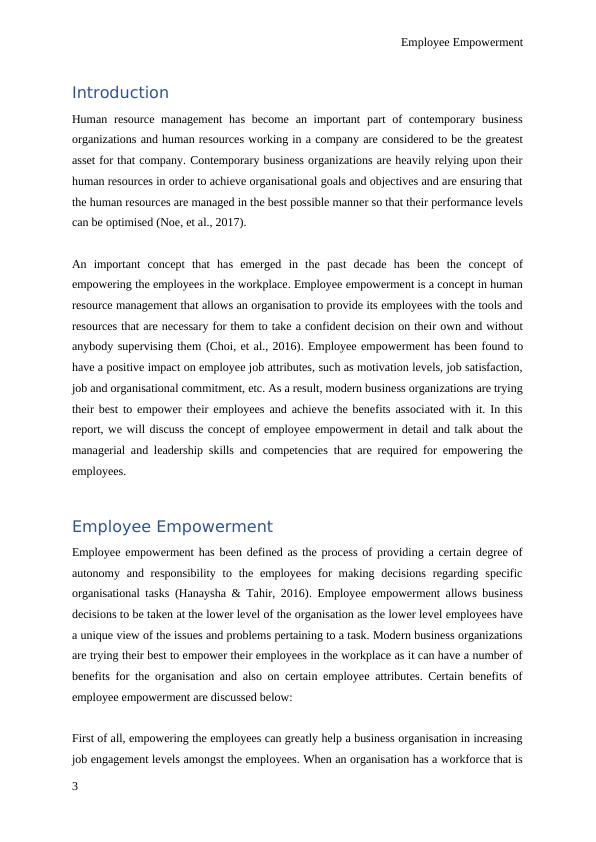Employee Empowerment
Added on 2023-01-18
13 Pages4001 Words54 Views
Employee Empowerment
MANAGING AND LEADING PEOPLE
– 954293
1
MANAGING AND LEADING PEOPLE
– 954293
1

Employee Empowerment
Table of ContentsIntroduction.......................................................................................................................3
Employee Empowerment...................................................................................................3
Managerial Leadership Skills and Competencies................................................................5
Conclusion.......................................................................................................................10
Bibliography....................................................................................................................11
2
Table of ContentsIntroduction.......................................................................................................................3
Employee Empowerment...................................................................................................3
Managerial Leadership Skills and Competencies................................................................5
Conclusion.......................................................................................................................10
Bibliography....................................................................................................................11
2

Employee Empowerment
Introduction
Human resource management has become an important part of contemporary business
organizations and human resources working in a company are considered to be the greatest
asset for that company. Contemporary business organizations are heavily relying upon their
human resources in order to achieve organisational goals and objectives and are ensuring that
the human resources are managed in the best possible manner so that their performance levels
can be optimised (Noe, et al., 2017).
An important concept that has emerged in the past decade has been the concept of
empowering the employees in the workplace. Employee empowerment is a concept in human
resource management that allows an organisation to provide its employees with the tools and
resources that are necessary for them to take a confident decision on their own and without
anybody supervising them (Choi, et al., 2016). Employee empowerment has been found to
have a positive impact on employee job attributes, such as motivation levels, job satisfaction,
job and organisational commitment, etc. As a result, modern business organizations are trying
their best to empower their employees and achieve the benefits associated with it. In this
report, we will discuss the concept of employee empowerment in detail and talk about the
managerial and leadership skills and competencies that are required for empowering the
employees.
Employee Empowerment
Employee empowerment has been defined as the process of providing a certain degree of
autonomy and responsibility to the employees for making decisions regarding specific
organisational tasks (Hanaysha & Tahir, 2016). Employee empowerment allows business
decisions to be taken at the lower level of the organisation as the lower level employees have
a unique view of the issues and problems pertaining to a task. Modern business organizations
are trying their best to empower their employees in the workplace as it can have a number of
benefits for the organisation and also on certain employee attributes. Certain benefits of
employee empowerment are discussed below:
First of all, empowering the employees can greatly help a business organisation in increasing
job engagement levels amongst the employees. When an organisation has a workforce that is
3
Introduction
Human resource management has become an important part of contemporary business
organizations and human resources working in a company are considered to be the greatest
asset for that company. Contemporary business organizations are heavily relying upon their
human resources in order to achieve organisational goals and objectives and are ensuring that
the human resources are managed in the best possible manner so that their performance levels
can be optimised (Noe, et al., 2017).
An important concept that has emerged in the past decade has been the concept of
empowering the employees in the workplace. Employee empowerment is a concept in human
resource management that allows an organisation to provide its employees with the tools and
resources that are necessary for them to take a confident decision on their own and without
anybody supervising them (Choi, et al., 2016). Employee empowerment has been found to
have a positive impact on employee job attributes, such as motivation levels, job satisfaction,
job and organisational commitment, etc. As a result, modern business organizations are trying
their best to empower their employees and achieve the benefits associated with it. In this
report, we will discuss the concept of employee empowerment in detail and talk about the
managerial and leadership skills and competencies that are required for empowering the
employees.
Employee Empowerment
Employee empowerment has been defined as the process of providing a certain degree of
autonomy and responsibility to the employees for making decisions regarding specific
organisational tasks (Hanaysha & Tahir, 2016). Employee empowerment allows business
decisions to be taken at the lower level of the organisation as the lower level employees have
a unique view of the issues and problems pertaining to a task. Modern business organizations
are trying their best to empower their employees in the workplace as it can have a number of
benefits for the organisation and also on certain employee attributes. Certain benefits of
employee empowerment are discussed below:
First of all, empowering the employees can greatly help a business organisation in increasing
job engagement levels amongst the employees. When an organisation has a workforce that is
3

Employee Empowerment
highly engaged in its work, it is able to offer better services to its customers and is also able
to make the business a better place.
Secondly, employee empowerment can be beneficial for a company in improving its
workplace culture and becoming an employer of choice for talented candidates. When an
organisation empower its employees, it can naturally attract talented employees because the
candidates that need to be instructed to do something will obviously go to other companies.
Slowly and steadily, talented employees start to take a notice of the empowerment levels that
an organisation can offer and will be attracted to such a company. Ultimately, having a
talented pool of employees will improve the entire work culture of business organisations as
well (Mitrefinch, 2017).
Thirdly, employee empowerment can have a huge impact on the productivity levels of an
organisation. In a study carried out by Zenger Folkman, it was discovered that only 4% of the
employees were willing enough to make extra efforts where employee empowerment levels
were low. On the other hand, in business organizations where employee empowerment levels
were significantly high, 67% of the employees were willing enough to provide an extra effort
to their organizations in achieving their goals and objectives (Folkman, 2017).
Fourthly, the process of problem solving boosts up to a great level. According to a survey
commissioned by LivePerson, 82% of the responding customers felt that the prime factor for
great customer services was that their problems were getting resolved within no time. When
employees are empowered in the workplace, they can take quick decisions to solve customer
problems when they approach them with their issues. As a result, a company can assure
higher quality customer care services to its customers and also increase the speed of problem
solving by empowering its employees (The Rtiz Carlton, 2015).
Lastly, empowered employees have been found to have greater levels of job satisfaction
because they know that their seniors trust them and are offering them a complete chance to
develop their skills and competencies. Employee empowerment makes the employees feel
more confident at work and can also have a positive impact on their performance levels
(Leonard, 2019).
4
highly engaged in its work, it is able to offer better services to its customers and is also able
to make the business a better place.
Secondly, employee empowerment can be beneficial for a company in improving its
workplace culture and becoming an employer of choice for talented candidates. When an
organisation empower its employees, it can naturally attract talented employees because the
candidates that need to be instructed to do something will obviously go to other companies.
Slowly and steadily, talented employees start to take a notice of the empowerment levels that
an organisation can offer and will be attracted to such a company. Ultimately, having a
talented pool of employees will improve the entire work culture of business organisations as
well (Mitrefinch, 2017).
Thirdly, employee empowerment can have a huge impact on the productivity levels of an
organisation. In a study carried out by Zenger Folkman, it was discovered that only 4% of the
employees were willing enough to make extra efforts where employee empowerment levels
were low. On the other hand, in business organizations where employee empowerment levels
were significantly high, 67% of the employees were willing enough to provide an extra effort
to their organizations in achieving their goals and objectives (Folkman, 2017).
Fourthly, the process of problem solving boosts up to a great level. According to a survey
commissioned by LivePerson, 82% of the responding customers felt that the prime factor for
great customer services was that their problems were getting resolved within no time. When
employees are empowered in the workplace, they can take quick decisions to solve customer
problems when they approach them with their issues. As a result, a company can assure
higher quality customer care services to its customers and also increase the speed of problem
solving by empowering its employees (The Rtiz Carlton, 2015).
Lastly, empowered employees have been found to have greater levels of job satisfaction
because they know that their seniors trust them and are offering them a complete chance to
develop their skills and competencies. Employee empowerment makes the employees feel
more confident at work and can also have a positive impact on their performance levels
(Leonard, 2019).
4

End of preview
Want to access all the pages? Upload your documents or become a member.
Related Documents
Human Resource Management : Assignmentlg...
|3
|883
|79
Best Practices in Human Resource Managementlg...
|7
|1862
|284
Developing Individuals Teams and Organisationslg...
|11
|3065
|290
Human Resource Management - Deskliblg...
|16
|1117
|232
Job Analysis: Purpose, Interrelationship with HR Functions, and Internal Political Issueslg...
|8
|1945
|54
Human Resource Management for Sustainable Organisational Performancelg...
|14
|4055
|350
